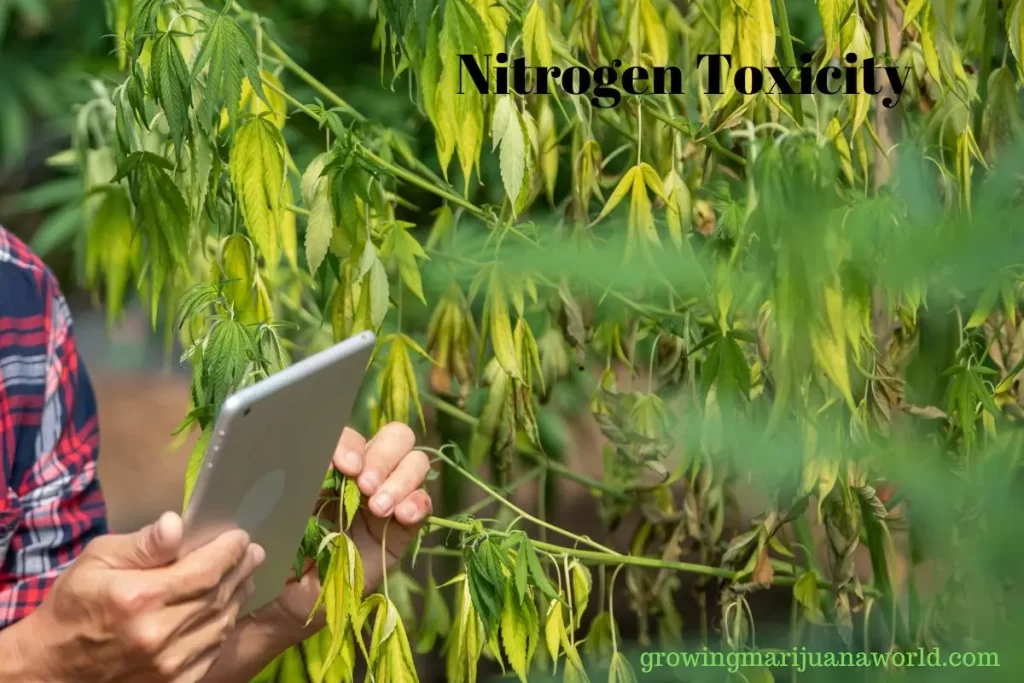Curling Leaves: Unraveling Nitrogen Toxicity in Marijuana Plants
Nitrogen is like the secret sauce that makes marijuana plants thrive – it’s what helps them grow big, strong, and healthy. But just like eating too many cookies can make you feel sick, too much nitrogen can harm the plants. That’s why in this article, we’re diving deep into why “Nitrogen Toxicity in Marijuana Plants” can be a big headache for marijuana growers.
We’ll chat about how to tell if your plants are getting too much nitrogen, why this happens in the first place, and most importantly, what you can do to fix it.
So, whether you’re a green thumb just starting out or a seasoned pro, this article is your go-to guide for keeping your plants in tip-top shape and ensuring they stay happy and thriving.
Understanding Nitrogen and its Role in Marijuana Growth
Nitrogen is like the fuel that powers a marijuana plant’s growth engine. It’s one of the key nutrients, along with phosphorus and potassium, that these plants need to thrive.
Think of it as the building blocks for all the important stuff that happens inside the plant, like making food through photosynthesis, building proteins, and kickstarting enzyme activity.
As marijuana plants grow, their needs change. During the early stages, known as the vegetative growth phase, they’re like hungry teenagers, gobbling up nitrogen to fuel their rapid growth spurt.
But as they transition into the flowering stage, their appetite for nitrogen decreases because they’re focused more on producing flowers than growing taller. So, understanding how nitrogen works and when your plants need it most is crucial for giving them the best shot at reaching their full potential.
The Importance of Nitrogen in Marijuana Cultivation
Nitrogen is a key component of chlorophyll, the pigment responsible for the green color of leaves, and is essential for photosynthesis, the process by which plants convert light energy into chemical energy. Adequate nitrogen supply promotes vigorous vegetative growth, robust stem and leaf development, and increased biomass accumulation, laying the foundation for optimal flowering and fruiting later in the plant’s life cycle.

Causes of Nitrogen Toxicity
Nitrogen toxicity often sneaks up on growers when they go a little overboard with fertilizing. Picture this: you’re trying to do your plants a favor by giving them some extra nutrients, but you end up pouring on way too much nitrogen-rich fertilizer.
It’s like giving someone a giant pizza when they only asked for a slice – too much of a good thing can quickly turn bad.
But that’s not the only way nitrogen toxicity can rear its ugly head. Sometimes, it’s the soil’s fault. If the soil doesn’t drain well and gets all soggy, it creates a perfect breeding ground for nitrogen overload.
Imagine your plants’ roots trying to take a breath underwater – not a pretty sight, right? Without enough oxygen, they can’t do their job properly, and that’s bad news for your plants.
And let’s not forget about pH – that magic number that determines how acidic or alkaline your soil is. If your soil pH is way off balance, it can mess with the availability of nitrogen to your plants.
Too acidic or too alkaline, and your plants won’t be able to absorb the nitrogen they need, leading to a buildup that spells trouble. It’s like trying to feed your plants a gourmet meal, but they can’t even taste it because the flavors are all off.
Recognizing Symptoms of Nitrogen Toxicity
While curling leaves are a prominent symptom of nitrogen toxicity, other signs include dark green foliage, burned leaf tips, and slowed growth. The curling of leaves typically begins at the tips and progresses towards the base of the leaf, giving them a claw-like appearance.
Visual aids, such as nutrient deficiency charts and comparison images, can aid growers in identifying nitrogen toxicity and distinguishing it from other nutrient disorders.
Effects of Nitrogen Toxicity on Marijuana Plants
Nitrogen toxicity can have detrimental effects on overall plant health and productivity. It can lead to reduced yield, stunted growth, and increased susceptibility to pests and diseases. Prolonged exposure to excess nitrogen can also disrupt the balance of other essential nutrients, further compromising plant health and vigor.
Diagnosing Nitrogen Toxicity
Diagnosing nitrogen toxicity in marijuana plants is like solving a mystery – you need clues from both the soil and the plants themselves to crack the case. Soil testing is your trusty detective tool, giving you insight into what’s going on beneath the surface.
By analyzing the nutrient levels in the soil, you can pinpoint if there’s too much nitrogen hanging around and causing trouble.
But that’s not the whole story. You also need to keep an eye on your plants for visual cues that something’s amiss. When it comes to nitrogen toxicity, your plants will start dropping hints if you know where to look.
Picture this: the leaves of your marijuana plants might start curling downward, almost like they’re wilting under the weight of too much nitrogen. They might also turn a dark, luscious green color, as if they’ve had one too many nutrient-rich smoothies.
But wait, there’s more! If you look closely, you might notice that the tips of the leaves are starting to look a little burnt or crispy around the edges. It’s like your plants are trying to tell you, “Hey, slow down with the nitrogen, buddy!”
So, when it comes to diagnosing nitrogen toxicity, it’s all about being a keen observer and using both soil testing and visual assessments to piece together the puzzle. By combining these detective skills, you’ll be able to spot nitrogen toxicity before it takes a toll on your precious plants.
Preventing Nitrogen Toxicity
Preventing nitrogen toxicity begins with adopting proper fertilization practices and using balanced nutrient formulations tailored to the specific needs of marijuana plants at each growth stage.
Maintaining adequate soil drainage, pH levels, and aeration is crucial for preventing nitrogen buildup and toxicity. Regular monitoring of soil nutrient levels and plant health allows growers to intervene early and prevent nitrogen toxicity before it becomes a problem.
Managing Nitrogen Toxicity
If nitrogen toxicity does occur, growers can employ several strategies to manage and mitigate its effects. Flushing the soil with clean water helps to leach excess nitrogen from the root zone, restoring a healthier nutrient balance. Adjusting fertilization schedules and using nitrogen-binding amendments, such as compost or organic matter, can help to reduce nitrogen levels in the soil and alleviate toxicity.

Fixing Nitrogen Toxicity
Identifying the source of excess nitrogen is crucial in addressing nitrogen toxicity in marijuana plants. Over-fertilization is a common culprit, where growers apply too much nitrogen-rich fertilizer in hopes of boosting growth but end up overwhelming the plants.
Poor soil drainage exacerbates the issue by trapping excess nitrogen in waterlogged soil, depriving roots of vital oxygen. Similarly, imbalanced pH levels can lock up nitrogen in the soil, making it unavailable to the plants or making it too accessible, leading to toxicity.
To remedy the situation, adjust your fertilization regimen by scaling back on nitrogen-heavy fertilizers and opting for balanced nutrient formulations. These formulations provide a more even distribution of nutrients, reducing the risk of nitrogen overload.
Improving soil drainage and aeration is also key. Incorporating organic matter such as compost or perlite helps loosen compacted soil, allowing water to drain freely and oxygen to reach the roots. Think of it as giving your plants room to breathe – they’ll thank you for it!
Check your soil pH and aim for the ideal range of 6.0 to 7.0 for marijuana plants. If the pH is too low, adding lime can raise it to the optimal level. Conversely, if it’s too high, sulfur can lower it back to the desired range.
Affiliate link: You will need a soil PH tester to get to the correct levels. Here are some options on Amazon.
In cases of severe nitrogen overload, a soil flush with clean water can help leach out excess nitrogen and restore balance to the nutrient profile. It’s like giving your plants a fresh start and a chance to thrive.
Lastly, keep a close eye on soil nutrient levels and plant health through regular monitoring and soil testing. This proactive approach allows you to catch any issues early on and make informed decisions to prevent nitrogen toxicity from recurring.
After all, a little vigilance goes a long way in ensuring the health and vitality of your marijuana plants.
Environmental Considerations
Environmental factors, such as temperature, humidity, and light intensity, can influence nitrogen uptake and toxicity in marijuana plants. Optimal environmental conditions promote efficient nutrient absorption and utilization, reducing the risk of nitrogen toxicity. Growers should strive to maintain stable environmental parameters to support healthy plant growth and minimize the incidence of nutrient disorders.
Case Studies and Practical Tips
Real-life case studies provide valuable insights into the occurrence and management of nitrogen toxicity in marijuana cultivation. Practical tips, gleaned from experienced growers, offer actionable advice for preventing and addressing nitrogen toxicity effectively.
Strategies such as soil testing, nutrient management, and environmental control are highlighted as key components of successful nitrogen toxicity management.
Conclusion
Nitrogen toxicity may seem like a formidable obstacle for marijuana growers, but armed with awareness, proactive management, and attentive care, it can be effectively tackled.
Understanding the intricate nuances of nitrogen toxicity, from its root causes to its telltale symptoms and far-reaching effects, empowers growers to safeguard plant health and enhance yield in their cultivation ventures.
By adopting a holistic approach to nutrient management and embracing best practices in fertilization, soil health, and environmental control, growers can create an optimal growing environment that minimizes the risk of nitrogen toxicity and promotes robust, flourishing plants.
In the world of marijuana cultivation, knowledge truly is power. With a keen eye, a commitment to ongoing learning, and a dash of patience, growers can navigate the complexities of nitrogen toxicity with confidence, ensuring the success and prosperity of their marijuana gardens. So, here’s to happy growing and bountiful harvests!
If you have any questions or helpful suggestions please submit a comment.


